13 books about Mobile communication systems
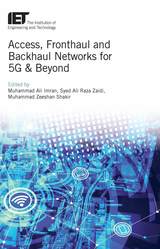
Access, Fronthaul and Backhaul Networks for 5G & Beyond
Muhammad Ali Imran
The Institution of Engineering and Technology, 2017
The widespread use of mobile internet and smart applications has led to an explosive growth in mobile data traffic, which will continue due to the emerging need of connecting people, machines, and applications in an ubiquitous manner through the mobile infrastructure. The efficient and satisfactory operation of all these densely deployed networks hinges on a suitable backhaul and fronthaul provisioning. The research community is working to provide innovative technologies with extensive performance evaluation metrics along with the required standardisation milestones, hardware and components for a fully deployed network by 2020 and beyond.
[more]
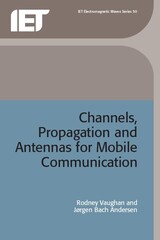
Channels, Propagation and Antennas for Mobile Communications
Rodney Vaughan
The Institution of Engineering and Technology, 2003
Written by two leading experts in the field, this exceptional book introduces the reader to the principles, theory and applications of physical layer wireless/mobile communications. In the area of wireless, the antennas, propagation and the radio channel used are inter-related; this book offers an explanation of that relationship, which is fundamental to the development of systems with high spectral efficiency.
[more]
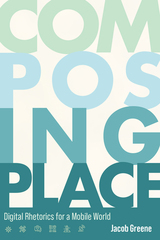
Composing Place
Digital Rhetorics for a Mobile World
Jacob Greene
Utah State University Press, 2022
Composing Place takes an innovative approach to engaging with the compositional affordances of mobile technologies. Mobile, wearable, and spatial computing technologies are more than the latest marketing gimmick from a perpetually proximate future; they are rather an emerging composing platform through which digital writers will increasingly create and distribute place-based multimodal texts. Jacob Greene utilizes and develops a rhetorical framework through which writers can leverage the affordances of these technologies by drawing on theoretical approaches within rhetorical studies, multimodal composition, and spatial theory, as well as emerging “maker” practices within digital humanities and critical media studies, to show how emerging mobile technologies are poised to transform theories, practices, and pedagogies of digital writing.
Greene identifies three emerging “modalities” through which mobile technologies are being used by digital writers. First, to counter dominant discourses in contested spaces; second, to historicize entrenched narratives in iconic spaces; and third, to amplify marginalized voices in mundane spaces. Through these modalities, Greene employs Indigenous philosophies and theories that upend the ways that the discipline has centered placed-based rhetorics, offering digital writers better strategies for using mobile media as a platform for civic deliberation, social advocacy, and political action.
Composing Place offers close analyses of mobile media experiences created by various artists and digital media practitioners, as well as detailed overviews of Greene’s own projects (also accessible through the companion website: www.composingplace.com). These projects include a digital “countertour” of SeaWorld that demonstrates the ways in which the attraction is driven by capitalism; an augmented reality tour of Detroit’s Woodward Avenue; and a mobile advocacy project in Jacksonville, Florida, that demonstrates the inequitable effects of car-centric public infrastructure. Ultimately, by engaging with these theoretical frameworks, rhetorical design principles, and pedagogical practices of mobile writing, readers can utilize the unique affordances of mobile media in various teaching and research contexts.
Greene identifies three emerging “modalities” through which mobile technologies are being used by digital writers. First, to counter dominant discourses in contested spaces; second, to historicize entrenched narratives in iconic spaces; and third, to amplify marginalized voices in mundane spaces. Through these modalities, Greene employs Indigenous philosophies and theories that upend the ways that the discipline has centered placed-based rhetorics, offering digital writers better strategies for using mobile media as a platform for civic deliberation, social advocacy, and political action.
Composing Place offers close analyses of mobile media experiences created by various artists and digital media practitioners, as well as detailed overviews of Greene’s own projects (also accessible through the companion website: www.composingplace.com). These projects include a digital “countertour” of SeaWorld that demonstrates the ways in which the attraction is driven by capitalism; an augmented reality tour of Detroit’s Woodward Avenue; and a mobile advocacy project in Jacksonville, Florida, that demonstrates the inequitable effects of car-centric public infrastructure. Ultimately, by engaging with these theoretical frameworks, rhetorical design principles, and pedagogical practices of mobile writing, readers can utilize the unique affordances of mobile media in various teaching and research contexts.
[more]
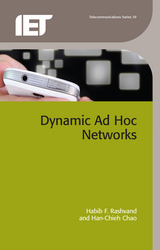
Dynamic Ad Hoc Networks
Habib F. Rashvand
The Institution of Engineering and Technology, 2013
Motivated by the exciting new application paradigm of using amalgamated technologies of the Internet and wireless, the next generation communication networks (also called 'ubiquitous', 'complex' and 'unstructured' networking) are changing the way we develop and apply our future systems and services at home and on local, national and global scales. Whatever the interconnection - a WiMAX enabled networked mobile vehicle, MEMS or nanotechnology enabled distributed sensor systems, Vehicular Ad hoc Networking (VANET) or Mobile Ad hoc Networking (MANET) - all can be classified under new networking structures which can be given the generic title of 'ad hoc' communication networking.
[more]

Finding Augusta
Habits of Mobility and Governance in the Digital Era
Heidi Rae Cooley
Dartmouth College Press, 2014
Winner of the 2015 Anne Friedberg Innovative Scholarship Award from the Society for Cinema and Media Studies Finding Augusta breaks new ground, revising how media studies interpret the relationship between our bodies and technology. This is a challenging exploration of how, for both good and ill, the sudden ubiquity of mobile devices, GPS systems, haptic technologies, and other forms of media alter individuals’ experience of their bodies and shape the social collective. The author succeeds in problematizing the most salient fact of contemporary mobile media technologies, namely, that they have become, like highways and plumbing, an infrastructure that regulates habit. Audacious in its originality, Finding Augusta will be of great interest to art and media scholars alike.
[more]
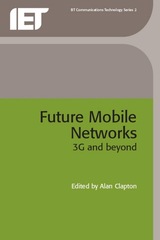
Future Mobile Networks
3G and beyond
Alan Clapton
The Institution of Engineering and Technology, 2001
This book explores the future of mobile communications networks from 3G trials, developments and products, to what will follow in the future. The increasing demands for services and higher quality continue to drive forward the technological capabilities. The implications of increasing mobile customer numbers on a global scale are investigated, as well as the convergence of mobile and the Internet, which, it is envisaged, will provide the next massive growth burst to the mobile market and 3G networks.
[more]

Going Mobile
Developing Apps for Your Library Using Basic HTML Programming
Scott American Library Association
American Library Association, 2012
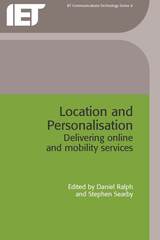
Location and Personalisation
Delivering online and mobility services
Daniel Ralph
The Institution of Engineering and Technology, 2004
The world is charging towards the new network technologies of broadband and 3G, and new application technologies face the challenge of where they can be used. This book takes a pragmatic look at two particular application technologies - location and personalisation - and presents an understanding of the technical and business impact of these technologies. With a combination of overview papers, detailed technical case studies and a deep understanding of actual implementatio of these services within a telecommunications environment, this book will help those wishing to deliver improved services based on these capabilities. Other key topics covered include CRM and content management.
[more]

Mobile Technology And Academic Libraries
Innovative Services
Robin Canuel
Assoc of College & Research Libraries, 2017

Security for Mobility
Chris J. Mitchell
The Institution of Engineering and Technology, 2004
Over the last two decades, mobile telecommunications has grown dramatically, from a small niche technology to a massive industry. Mobile telephones are now ubiquitous, and the divisions between PCs, PDAs, mobile telephones and other mobile devices are becoming increasingly blurred. Against this background, the security of information of both the devices themselves, and the information handled by these devices, is becoming ever more important.
[more]
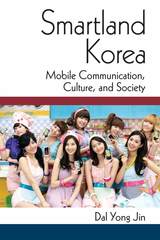
Smartland Korea
Mobile Communication, Culture, and Society
Dal Yong Jin
University of Michigan Press, 2017
The dramatic advancement of cellphone technology has fundamentally changed our daily lives. Smartphones and their applications have created new capital for information and communication technology corporations and changed the way people communicate. Because of an interesting awareness of the significance for digital economy and people’s daily culture, many countries, from the U.S. to China, have massively invested in the smartphone industries since the early 21st century. Among them, South Korea has become one of the centers for technology development and digital culture, although the country was once lagging behind in the penetration of the phones and their apps. Yet within the last few years, the country has taken a big step toward their goal of becoming a ‘mobile game wonderland’ by appropriating smartphones and it now exists as a curious test-bed for the future of smartphone technology. Smartland Korea, as the first attempt to comprehensively analyze mobile communication in the context of Korean smartphones, looks into a largely neglected focus of inquiry, a localized mobile landscape, with particular reference to young Koreans’ engagement with their devices and applications. Dal Yong Jin focuses not only on the celebratory achievement of technological advancement, but also the significance of social milieu in the development of the smartphones. He situates the emergence of smartphones within the growth of mobile technologies and overall telecommunications industries embedded in Korea’s information and communication technologies. The book examines the technology’s innovation and the evolution, the digital economy through the lens of political economy, and the youth culture embedded in the Korean smartphone context.
[more]

Spread Spectrum in Mobile Communication
Olav Berg
The Institution of Engineering and Technology, 1998
Mobile communication is one of the most important applications in the tele-communications and IT field. Developments in technology are enabling the design of advanced mobile radio networks linking information processing and data routing, with the radio segment sandwiched between layers of digital signal processors. Spread spectrum technology adapts radio communication to computational data information processing networks.
[more]

Usability and the Mobile Web
A LITA Guide
American Library Association
American Library Association, 2015
READERS
Browse our collection.
PUBLISHERS
See BiblioVault's publisher services.
STUDENT SERVICES
Files for college accessibility offices.
UChicago Accessibility Resources
home | accessibility | search | about | contact us
BiblioVault ® 2001 - 2024
The University of Chicago Press









